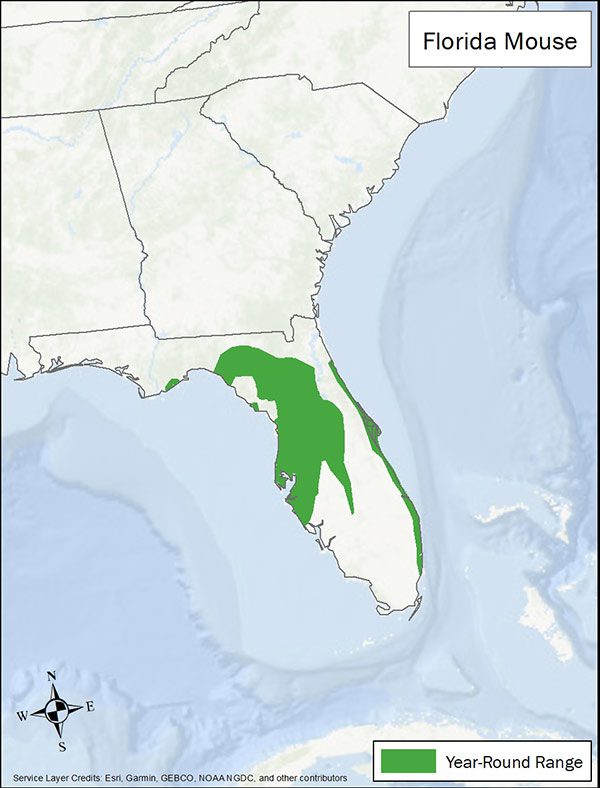LandPKS Learning
Habitat Hub

Florida Mouse
While the Florida mouse commonly occupies the same burrows as its predators, including snakes, it avoids predation by digging a different entrance and creating side tunnels.
Podomys floridanius
Identification
The Florida mouse, also known as the Florida deer mouse, reaches a length of 8.0 in/20.3 cm and weighs 0.7-1.7 oz/36.9-49 g. The tail makes up about 80% of its body length. The mouse has yellow-brown short fur with a white underbelly and moderately big ears without fur. The Florida mouse has five footpads on each foot, while all other deer mice have six footpads on each foot.
The Florida mouse lives exclusively in the state of Florida. It is found from coast to coast mainly in the north central region of the state. Their predators include snakes, owls, and birds of prey. They likely breed throughout the year, but more commonly from fall to early winter. The mouse will reproduce no more than two litters each year. Each litter usually consists of two to three offspring.
Observation Tips
The Florida mouse is dependent on gopher tortoise burrows for shelter. They are nocturnal and emerge at night to forage on a diet of seeds, acorns, fruits, and insects. During the day they remain inactive in these burrows.
Interesting Fact
While the Florida mouse commonly occupies the same burrows as its predators, including snakes, it avoids predation by digging a different entrance and creating side tunnels.
Ideal Habitat
The Florida mouse prefers xeric upland communities with dry, well-drained sandy soils, such as scrub (including scrubby flatwoods, oak scrub, sand pine scrub, rosemary scrub) and sandhills. Vegetation is sparse shrubs (10-60%) and ground cover and patches of bare ground with trees being <25%. Historically, this habitat structure was maintained by natural fire every 4-10 years. Florida mice excavate their burrows inside the burrows of animals, often the gopher tortoise. They will also use burrows of armadillos or other mice.

Range map provided by International Union for Conservation of Nature
Management Activities that Benefit Species – Best Management Practices (BMPs)
In the absence of naturally occurring fire, prescribed burning is necessary to maintain the open and sparse vegetation structure suitable for the Florida mouse. When possible, prescribed fires should be limited to the spring and early summer months to achieve a mosaic of burned and unburned patches. As the Florida mouse largely depends on the burrows of gopher tortoises, any activities that improve the habitat of gopher tortoises will also benefit the Florida mouse.
Reduced genetic variation makes Florida mouse populations more susceptible to diseases or other disasters that may occur. Therefore, coordination between public and private landowners is beneficial for maintaining large habitat areas and increasing connectivity between mouse populations.
Management Activities to Avoid
Avoid large-scale development and agricultural conversion as it isolates mouse populations and destroys habitat. The removal of oak trees is another threat to the Florida Mouse and other endemic species. Oak trees and other seed-bearing plants play a significant role in their habitat as a food source through mast reproduction of seeds. Avoid conducting prescribed fire in the fall during peak breeding season as the removal of cover impacts available food resources and increases predation risk. Additionally, the increase in native (i.e. racoons) and nonnative predators (i.e. cats, red fire ants) can threaten mouse populations.
Other Species that Benefit from Similar Habitat Management
Other species that benefit from high-quality natural xeric uplands include the Florida scrub-jay, gopher tortoise, red-cockaded woodpecker, and the eastern indigo snake.
Download
Download the Florida mouse Factsheet
Descarga la ficha de el ratón de Florida
Other Resources
Florida Fish and Wildlife Conservation Commission. Florida mouse
NatureServe: 2021. NatureServe Explorer: An online encyclopedia of life [web application]. Version 7.1. NatureServe, Arlington, Virginia. Florida mouse
Florida Natural Areas Inventory. Florida mouse field guide
International Union for Conservation of Nature (IUCN). 2019. The IUCN Red List of Threatened Species. Version 2019-3. Florida mouse
Photo credit: Bill Chitty/Flickr
Mobile App | Data Portal | Knowledge Hub | Habitat Hub | Learning Collections | Blog | About | Contact | Support



